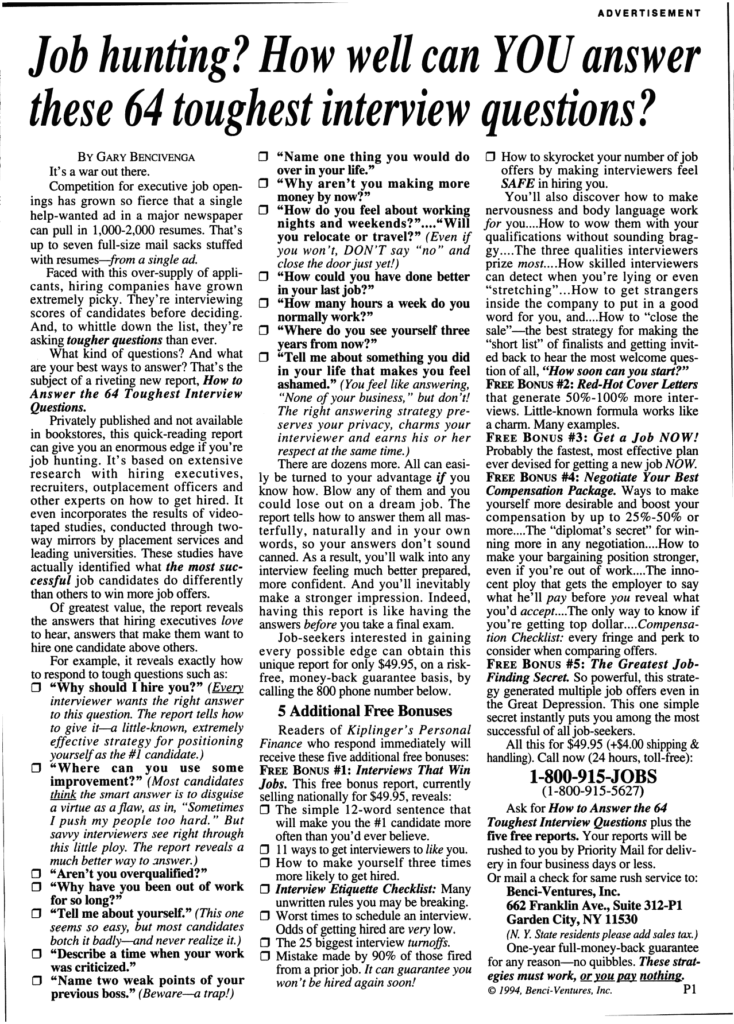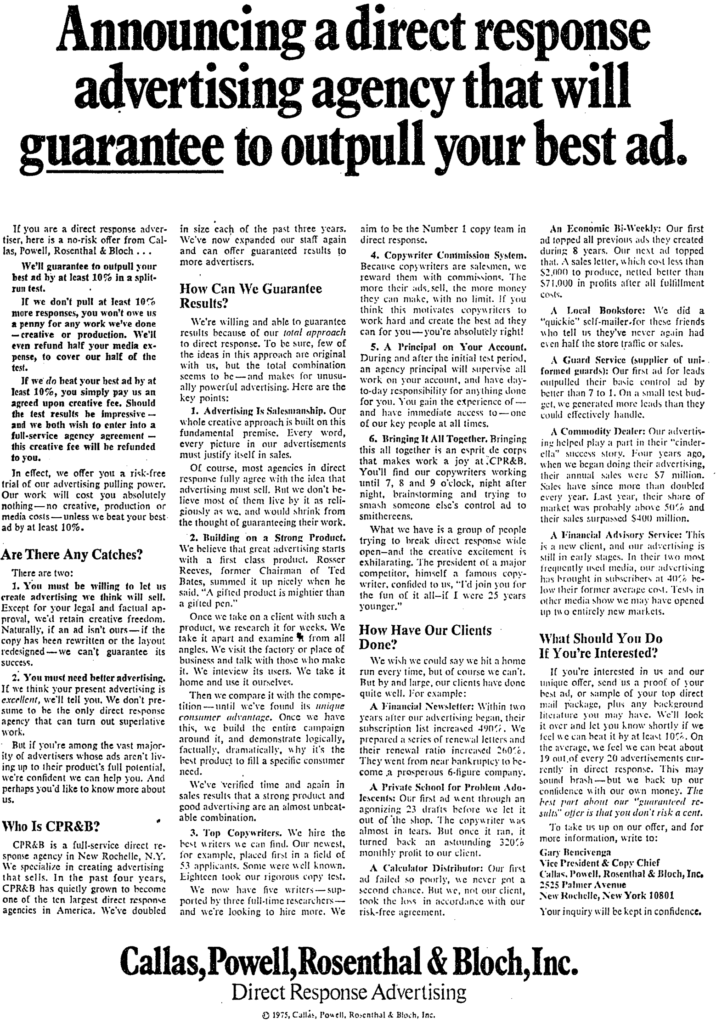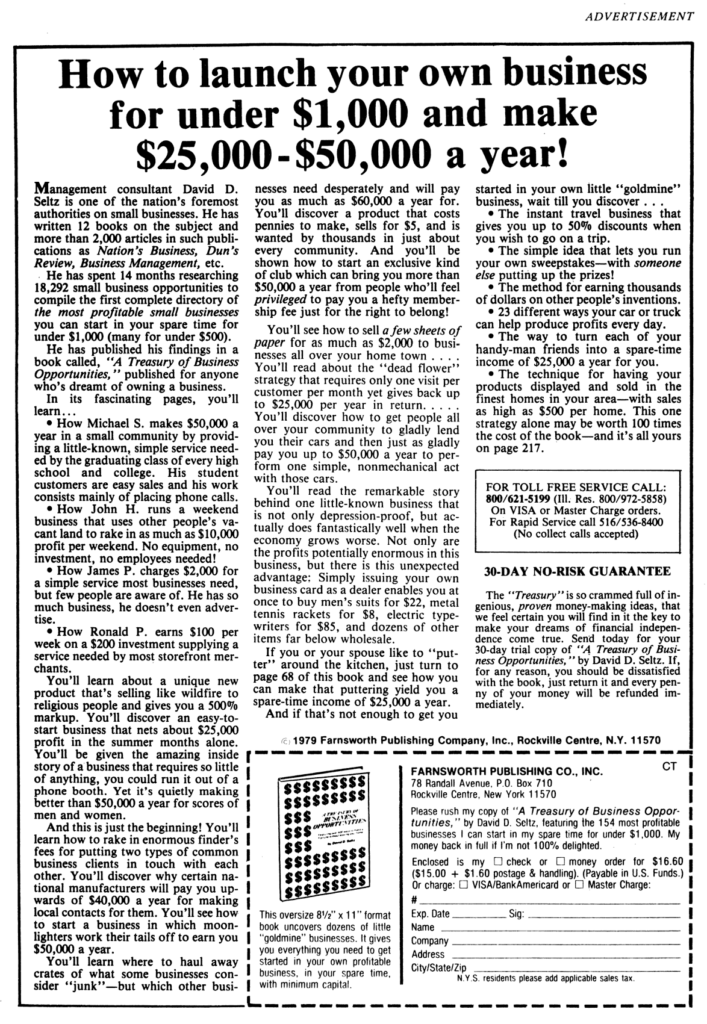For the past two weeks, I have copyworked and analysed 5 of Gary Bencivenga’s print ads.
Swipe file at the bottom of the page.
“What is copywork?” you may ask.
Copywork is copying others’ work by hand to experience their writing style and techniques.
I did so with 5 of Bencivenga’s ads, analysed their structure – so you don’t have to – and took the notes below.
I hope these Bencivenga “bullets” improve your writing, as it has mine.
- Bullet 1: Gary Bencivenga’s Formula – Positivity
- Bullet 2: Bold Claims and Strong Guarantees
- Bullet 3: Establishing Authority
- Bullet 4: Future Pacing
- Bullet 5: Headlines, Benefits and Bonuses
- Bonus Bullet 1: Bencivenga Book Ad Formula
- Bonus Bullet 2: Bencivenga Report Ad Formula
- Gary Bencivenga Swipe File
- Lessons From Other Great Writers
Bullet 1: Gary Bencivenga’s Formula – Positivity
Bencivenga’s writing focuses on:
- taking away concerns
- bold claims and increasing belief of the reader in the product or service
- whatever he sells requires little (perceived) effort and time from the reader
- giving free value upfront (instant gratification)
- no-questions-asked cancellation policy. He makes use of commitment bias; both his writing and the reader’s journey are a ‘slippery slope’.
The overall message is positive, focuses on the benefits and what the future looks like after use (future pacing).
He rarely – if ever – addresses a reader’s potential concerns about the product or service.
Bullet 2: Bold Claims and Strong Guarantees
What stands out about Bencivenga’s writing are his bold claims. Everything in his ads screams conviction that the reader will achieve the desired outcome.
He uses strong guarantees and unflinching promises as the premise of his offers.
Bold guarantees are incredibly powerful as they take away a reader’s fear of failure.
All of Bencivenga’s ads I’ve analysed contained a money-back guarantee and a strong promise.
These guarantees are likely to make you more money versus losing money from return purchases.
A common Bencivenga closing sentence: “You have nothing to lose”
This statement reaffirms there is no ‘cost’ or ‘loss’ right now.
Bencivenga backs this up with a generous cancellation policy and a no-follow-up promise.
Bullet 3: Establishing Authority
Bencivenga spends less than 10% of the text to establish the authority of the product or service.
Instead, he lets case studies and results do the talking for him.
Interestingly, he throws in the occasional failure too, favouring transparency and realism over a ‘it’s too good to be true’-perception.
He also uses figures in two ways:
- Low figures when mentioning cost or effort from the reader
- Including breaking up high dollar costs into smaller amounts.
For example, going from $ 270 total to “$10 for each of the 27 lessons”
- Including breaking up high dollar costs into smaller amounts.
- High figures when mentioning the expected upside of the product or service.
Bullet 4: Future Pacing
Focuses the majority of his ads on future pacing supported by either (1) easy-to-implement, no-cost benefits or (2) many, short case studies.
Addresses the reader directly with “you” and uses a lot of future-pacing – making the reader imagine a scenario for themselves.
Reduces the reader’s issues by making them:
- “Common” problems that everyone suffers from
- Reducing the severity, for example: “innocent mistakes”
Bullet 5: Headlines, Benefits and Bonuses
Bencivenga likes to call out his market in the headline or first section. Readers will self-select.
Bencivenga uses 5 types of benefits:
- Existing actions: use words like “uncover” and “tap the hidden value” for things that the reader is already doing. Illustrates that they can benefit without additional effort.
- Perceived difficult actions: “how to”, “guidelines”, “key rules” or doubling up and showing a complete solution with “when – and why”, “the best – and worst”, “ins and outs”. Displays expertise and reduces perceived complexity at the same time.
- Unaware actions: “harness the power of compounding”, “a plan”, “the single best way”, “opportunities”. These let the reader in on secrets they don’t know or fully understand. They also help the reader decide if they are a good fit with the product or service (aka “I already know this” vs “I don’t know this yet”).
- Educational: using “why”, “how” and “when” statements followed by a solution. This also displays shows expertise and increases the perceived value because of the “effort” or “time” it saves the reader.
- Done-for-you actions: “a review of”, “sample”, “key rules”, “key steps” often followed by a positive outcome that everyone desires. These are mixed in among the others to reduce doubt as the reader will surely say “I want this” to these statements and continue reading. Continuing to read = increasing commitment = increasing the likelihood of saying ‘yes’ at the end.
Benefits and bonuses consist of 1~2 sentences.
- Every bonus provides “many” ways and strategies. This increases the perceived odds of success when using the product and thereby perceived value.
- The bonuses increase the perceived value of the main product without talking about the main product.
- Any negative outcome becomes something ‘everyone’ does, while positive outcomes are exclusive to ‘you’ (i.e. the reader) and something ‘everyone’ is unaware of or doesn’t know. Meaning: ‘you’ can become part of an exclusive club and get an edge.
- Every benefit either mentions (1) something the reader will be able to do afterwards or (2) an outcome he desires and hasn’t been able to achieve yet.
- Later benefits become more outrageous, almost “too good to be true”. It works because of a slippery slope of believability (a term I came up with).
- He ends with a reaffirmation of what the reader ultimately wants and what was promised at first, but now backed with a belief system that it’s possible as a result of all the benefits.
Bencivenga adds further value and intrigue with enticing bonuses that drive the sale.
Bonus Bullet 1: Bencivenga Book Ad Formula
- Call out your market in the headline
- Build credibility by highlighting the expert’s accomplishments
- Build trust by showcasing how others have achieved results
- Generate excitement by future pacing the results for the reader
- Prepare the prospect to make a decision by using “if” statements
- Pull the reader toward saying, “YES!” with more future pacing statements
- Ask for the sale (CTA)
- Back it with a guarantee
See below example ad: Gary Bencivenga Print Ad – How to launch your own business
Bonus Bullet 2: Bencivenga Report Ad Formula
- Creating fascination around the content of a book or product without giving away the actual content.
- Focus the majority of the ad on teasing the prospect about what’s in the report.
- Follow this up with an offer that is driven by enticing bonuses.
- Pile on bonuses. These will push the sale.
Bonuses can be used this way to encourage the purchase of a core product that might not have sold as well on its own.
See below example ad: Gary Bencivenga Print Ad – Do You Make These Mistakes In Job Interviews
Gary Bencivenga Swipe File





Pingback: Joseph Sugarman - How To Write Addictive Copy